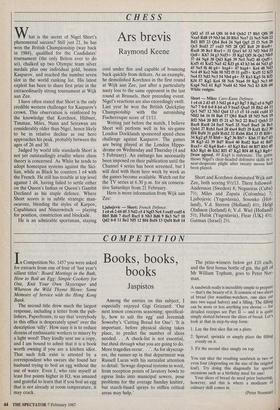COMPETITION
Books, books, books
Jaspistos
In Competition No. 1457 you were asked for extracts from one of four of 'last year's silliest titles': Board Meetings in the Bath, How to Boil an Egg: Simple Cookery for One, Knit Your Own Skyscraper and Whereon the Wild Thyme Blows: Some Memoirs of Service with the Hong Kong Bank.
The second title drew much the largest response, including a letter from the pub- lishers, Paperfronts, to say that 'everybody in this office is desperately upset' over the description 'silly'. How easy it is to reduce dozens of enthusiastic workers to misery by a light word! They kindly sent me a copy, and I am bound to admit that it is a book worth owning if you are a kitchen idiot. That such folk exist is attested by a correspondent who swears she found her husband trying to boil an egg without the use of water. Even I, who rate myself at least five points higher in IQ, was amazed and grateful to learn that if you boil an egg that is not already at room temperature, it may crack. Among the entries on this subject, I especially enjoyed Gigi Grizzard: 'Our next lesson concerns seasoning; specifical- ly, how to salt the egg' and Jeremiah Sowerby's 'Cutting Bread for One': 'It is important, before physical slicing takes place, to predict the number of slices needed. . . A check-list is not essential, but think through what you are going to do. More tragedies occur. . .'. As for skyscrap- ers, the runner-up in that department was Russell Lucas with his surrealist attention to detail: 'Sewage disposal systems in wool, from reception points of lavatory bowls to egress links into municipal sewers, pose problems for the average Sunday knitter, but starch-based sprays to stiffen critical areas may help.' The prize-winners below get £10 each, and the first bonus bottle of gin, the gift of Mr William Topham, goes to Peter Nor- man.
A sandwich really is incredibly simple to prepare — that's the beauty of it. It consists of two slices of bread (for waistline-watchers, one slice cat into two equal halves) and a filling. The filling can be more or less anything you choose — for detailed receipes see Part II — and it is quite simply slotted between the slices of bread. Let's look at that in step-by-step form:
1. Lay the first slice flat on a plate.
2. Spread, sprinkle or simply place the filling evenly on it.
3. Fit the second slice snugly on top.
You can slice the resulting sandwich in two or even four (depending on the size of the original loaf). Try doing this diagonally for special occasions such as a birthday meal for one!
Your slices of bread do need prior buttering, however, and this is where a modicum of culinary skill comes in. . . .
(Peter Norman) For this special treat select the egg carefully: its shape should be even, its texture smooth, its colour an ebullient fawn. Much could be said about choice of water: it frankly makes no difference so long as you eschew anything from the Thames and use a softener. More important is the baptism. Never heat the water without the egg or it may crack. Using a spoon, lower the egg into a saucepan of cold water. Then light the gas (the author strikes a Swan Vesta, but that is not obligatory), and gently increase the water temperature until it comes to an even boil (see Chapter 7: Is the Water Boiling?). No one can say how long to keep the egg in the water. That depends on age of egg and efficiency of stove. It must be established for each batch by a series of test boils. (Rob Hull) Standing among so much marble — heated only by a charcoal brazier in those days — was decidedly chilly in the season of the tai fong (great wind, or typhoon). I went shopping for long-johns in the narrow lanes of Kowloon. Those I found were of inferior quality and the sizes were for diminutive small-hammed Orien- tals. How in that windy outpost of Empire I yearned for snug all-English Chilprufe!
My birthday fell in September. One evening I escorted Artemisia to one of her aunt Lady Badgett's folk-song concerts in the music-room of Government House. In the interval Artemi- sia, who had got wind of my birthday, asked if there was anything I especially wanted. I thought, Hang it! and whispered in her ear. Later I saw her, all dimples, conferring with Lady Badgett. What a grand girl! The two must have wired to the Army and Navy Stores at home and had two pairs of perfect Chilprufe sent out with the Royal dispatches.
(George Moor) One of the most tedious commonplaces of the spy movie is the scene where two moronic incompetents of the kind eminently recruitable for espionage turn on the taps of the hotel bathroom to full gush — and then have to bellow their secrets at one another in order to be heard. A better way to beat the bugs is actually to get into the bath; and, in these days of commercial espionage, many boards are finding themselves — if they wish to preserve any industrial secrets whatsoever — obliged so to do. However, the shocking news that a full board of Meganational Flotations held in a giant jacuzzi was effectively overheard by a device similar in its mode of operation to the wartime ASDIC has led to a hunt for a totally non-sound-conductive medium for boards to bathe in; and I am happy to report that a well-known brand of proprietary stout.. .
(Jon Fernside) . . . Or, if you prefer a more modest beginning, try working a tower block. All you need are a pair of knitting needles, a plentiful supply of wool, and perseverance. My own first attempt, inspired by the sight of a magnificent, fully- dimensional knitted pagoda, was, I fear, nothing more ambitious than a log cabin. But so realistic did it look, knitted in a broken reversed stocking stitch, that I immediately began a red-brick Georgian house. A friend constructed a delight- ful replica of Anne Hathaway's cottage — cable stitch providing the timbered effect. Of course thatched roofs are so simple that one almost feels one is cheating. There is, naturally, more artistic satisfaction in the judicious placement of purl stitches to suggest a tiled roof.
I myself have just completed a copy of the Post Office Tower. Instructions for this and many other edifices will be found in the follow- ing pages.
(Jeanne Fielder)



















































 Previous page
Previous page